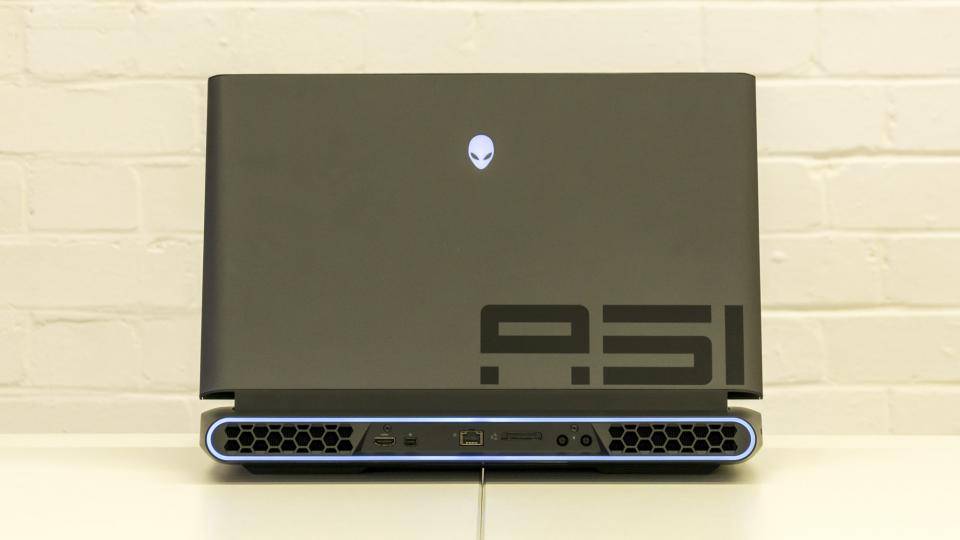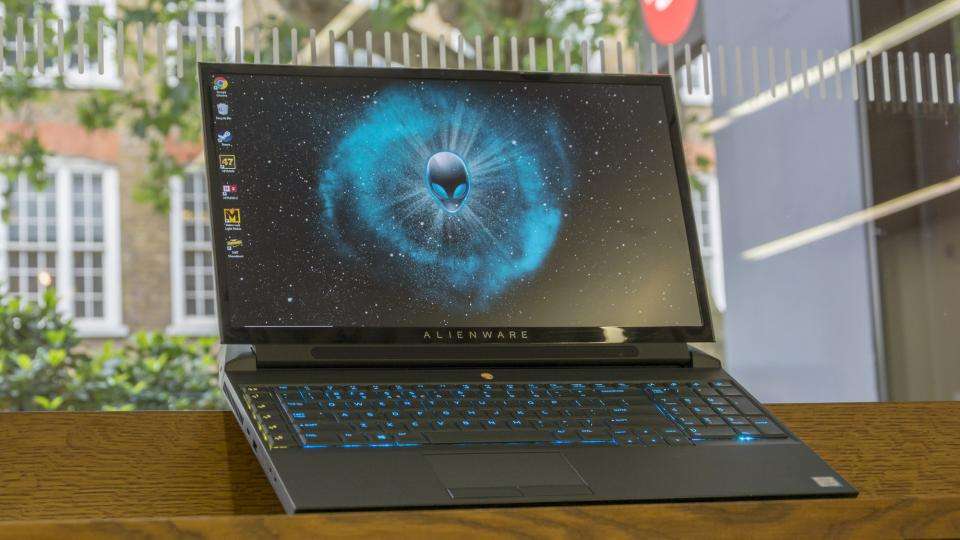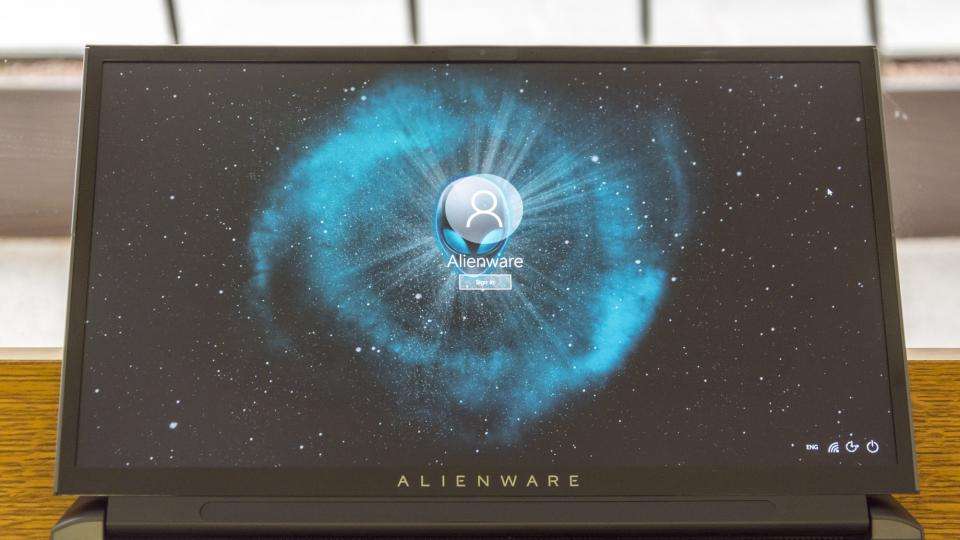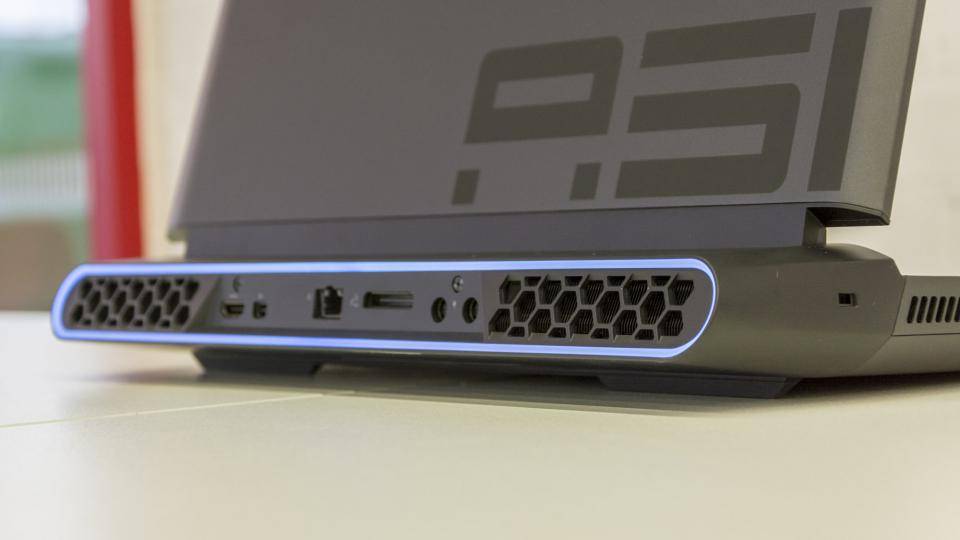Originally unveiled at CES 2019 in Las Vegas, the Alienware Area-51m gaming laptop has finally landed in the UK. And it’s made quite a splash, not least due to its massive bulk. This is one laptop you wouldn’t want atop your lap: it weighs nearly 4kg and needs not one but two chunky power bricks to run at its full potential.
Then again, the Alienware Area-51m has one big advantage over smaller, sleeker rivals: it is, by a huge margin, the most powerful laptop ever tested at Expert Reviews, and while it may not be light, it’s a heck of a lot easier to lug around than a desktop system. So what’s the catch? Well, do you happen to have a spare £4,000 handy?
READ NEXT: Best gaming laptops of the year
Alienware Area 51-m review: What you need to know
Dell’s Alienware brand produces some of the most desirable – and expensive – gaming hardware on the market, and the Alienware Area-51m is its new flagship laptop. Its 17.3in display has a Full HD resolution and a 144Hz refresh rate, with support for Nvidia’s G-Sync technology and Tobii eye-tracking software.
The internal specs are even more impressive. The model I tested is powered by a desktop-class Intel Core i9-9900K processor (released in late 2018), with a base clock speed of 3.6GHz and overclocking potential up to a stratospheric 5.5GHz. There’s also 32GB of RAM (expandable to 64GB) and an Nvidia GeForce RTX 2080 GPU with a dedicated 8GB of GDDR6. Storage is split between a 512GB PCIe SSD and a 1TB hybrid drive.

Quite frankly, it’s an absurd configuration. I’ve never encountered a laptop with this much power in my life – and, needless to say, it eats up a lot of energy. The machine comes with two chunky PSUs, supplying a combined 510W of power, and features a hefty 90Wh battery with an actual charge capacity of around 85.7Wh.
Buy now from Dell
Alienware Area 51-m review: Price and competition
The closest buyable model to this configuration of the Alienware Area-51m costs £4,000 from Amazon (or £3,999, if you want to get specific). That puts it well out of reach for most gaming enthusiasts. Even some of the most expensive desktops in our list of the best PCs don’t cost that much.
Admittedly, the Alienware Area-51m is much easier to transport than a PC. With a decently-sized backpack, you can take it anywhere. Indeed, it’s a lot more portable than the Acer Predator 21X , a ludicrous £9,000 gaming laptop that arrived at the Expert Reviews labs inside what appeared to be a bazooka case. It’s much more up to date too: the Predator 21X’s Core i7-7820HK CPU looks laughably underpowered compared to today’s gaming laptops.
In performance terms, the Alienware Area-51m’s closest rival is probably the Acer Predator Helios 500 . This has a similar display to the Area-51m, and the model I tested came with a 2.9GHz Intel Core i9-8950HK CPU, 16GB of RAM and Nvidia GeForce GTX 1070 graphics. At the time this made it was the speediest laptop we had tested, and although the Area-51m has now taken that title, the Helios 500 is far more affordable, as our review spec costs £2,300 .
There are a number of 15in alternatives to consider too. The Alienware m15 (2018) comes with an Intel Core i7-8750H and NVIDIA GeForce GTX 1070 graphics, though at £2,450 it’s overpriced. Asus’ Republic of Gamers brand includes some solid contenders too, such as the Asus ROG Zephyrus S GX701 , which features a Core i7-8750H and RTX 2080 graphics for £3,200 , and the £2,800 ROG Strix Scar III , which combines an Intel Core i9-9880H with an Nvidia GeForce GTX 2070 GPU. The Scar III is also one of the first laptops in the world to boast a screen with a 240Hz refresh rate – though whether you’ll notice any difference between this and a 144Hz panel is a question for another time.
Alienware Area 51-m review: Design
With its imposing metal chassis, jet engine exhausts and ovular lighting, the Alienware Area-51m looks like a prop from a Star Wars film. But it’s not in a galaxy far, far away: it’s sat right in front of me and taking up a whole lot of desk space. Measuring 403 x 319 x 42mm (WDH) and weighing in at around 3.9kg, it’s as chunky as they come. The two whopping power bricks that are required to run the CPU and GPU at their full speeds make it even more cumbersome.

The model I tested came with Alienware’s “Dark Side of the Moon” finish, which has all the sheen of a cast iron pan. If you build your Area 51-m configuration at the Dell webstore you can choose the sumptuous, all-white Lunar Light colour scheme instead, but not if you buy from Amazon.
The “exoskeleton” (Dell’s term) of the Area-51m is made of a sturdy magnesium alloy that feels like it could stop a bullet. Sadly, the lid feels flimsy by comparison, and it features unpleasantly reflective bezels that border the 17.3in display. These can also be seen on the Alienware m15 and, as I said in that review, they’re a terrible design choice, looking tacky and distracting from the onscreen action. A webcam housed in the display’s forehead bezel can capture 720p footage at 30fps.

Dual stereo speakers are mounted on the front edge of the base, facing the user. They’re pretty loud, and dialogue comes through clearly, but bass is almost totally absent, so you’ll want to add the cost of a quality gaming headset onto your £4,000 budget. To test the built-in microphone I used a voice recorder app with the fans running at full blast; my voice lost some volume and clarity, but I was able to make out every word when I played it back.
READ NEXT: Best headsets for gaming
And let’s talk about those fans. For the Area-51m, Dell has created a thermal system that it calls “Advanced Alienware Cryo-Tech v.2.0”, which sounds awfully fancy and futuristic. This sucks in cool air through vents at the top and bottom of the base – you can actually see the fans working through the latter – and pumps out hot air at the sides and rear.

The usual array of heat pipes and finstacks also carry heat away from the main life-support systems. In day-to-day use, the fans can barely be heard, especially if the laptop is set to quiet mode mode via the Alienware Command Centre. However, switch to “Performance” or “Full Speed” modes and it’s just as obnoxiously loud as the Acer Predator Helios 500.
As for connectivity, there’s pretty much everything here that you could hope for. On the left edge, there’s a 3.5mm global headset jack alongside a 3.5mm combo jack; a little further up you’ll find a USB 3.1 Type-A port (with PowerShare capability) and a USB Type-C socket supporting Thunderbolt 3 and DisplayPort. Beyond the exhaust vent there’s a Kensington Security Slot, and two more USB 3.1 Type-A ports can be found on the right edge.
Around the back, meanwhile, sit HDMI 2.0 and mini-DisplayPort sockets, one Killer-branded Gigabit Ethernet port and a connector for an Alienware Graphics Amplifier – although with a top-spec system there’s really no need to add an external GPU. Finally, next to this are the dual DC power inputs for the Area-51m’s two power adapters. The alluring ovular lighting that surrounds the rear vents can be customised using the supplied AlienwareFX software, along with the glowing Alien head logos on the lid and base.
Buy now from Dell
Alienware Area-51m review: Keyboard and touchpad
Gaming laptop keyboards are a tricky thing. For this one, Dell has come up with a chiclet-style version of the Alienware “TactX” keyboard design, with a full set of keys, including a number pad on the right-hand side and a column of programmable shortcut keys at the left. I get the idea, but this doesn’t seem like a natural place for them: I found myself looking down a lot just to check I wasn’t hitting these instead of the Shift and Ctrl keys.
Action-wise, each key has exactly 2.2mm of travel and elicits a satisfying clunk when pressed. Beneath, a steel back plate makes typing reassuringly solid right across the board. However, I don’t like the lack of spacing between keys: they’re so close together that you can’t even slot a credit card between the gaps. It’s all right for gaming, but I’d prefer a bit more separation between keys to help avoid accidental presses.
READ NEXT: Best gaming keyboards
The keyboard also features per-key RGB lighting, customisable through the Alienware Command Centre. And I mean customisable: if you want to (and I don’t know why you would), you can set every single a key to a different colour. More practically, you can set the colours to highlight your most-used gaming keys, such as WASD.
On first booting up the laptop, the touchpad lights up too, with the same ethereal glow you see on the keyboard. I disabled this feature immediately, because it looks horrendous. Sadly, the touchpad itself isn’t all that great either. It has a frictious feel, as if it’s constantly in need of a clean, and sensitivity isn’t great, which can make fine cursor movements difficult. On such a large laptop, the touchpad could be bigger too – it’s not as if it hasn’t got space to work with. The left and right clickers below the touchpad are decent, but most gamers will probably benefit from investing in a decent gaming mouse .
Alienware Area-51m review: Display
The 17.3in display on the Area-51m offers a good experience, but not a great one. On paper, it’s a pretty standard gaming laptop screen, with a resolution of 1,080 x 1,920 and a refresh rate of 144Hz. Behind the scenes, Nvidia’s G-Sync technology works to eliminate screen tearing and latency issues.
Colour coverage is solid, with the Area-51m’s panel producing 94.6% of the sRGB gamut. Gamut volume is at 98%, which indicates a high level of overlap with the sRGB colour space that’s used for web content and most PC apps. Colour accuracy is less impressive though, with our display calibrator detecting an average Delta E of 1.99 – not up to scratch for professional-level video and photo editing. In particular, the panel has trouble with almost all shades of grey, and some shades of blue and purple.
Another letdown is contrast, which I measured at an unusually low 739:1. That means everything looks very slightly washed out; for comparison, the Alienware m15, Razer Blade 15 (2018) and Asus ROG Zephyrus S GX701 all have contrast ratios of around 1,400, and you can immediately see the difference. The panel’s maximum luminance of 324cd/m2 isn’t exceptional either: it’s bright enough for indoor conditions but if you’re playing beside a window on a sunny day, you’ll have to shut those curtains.
READ NEXT: Best gaming monitors
Alienware Area-51m review: Tobii eye-tracking
One interesting feature of the Area-51m is the Tobii eye-tracking technology, which enables you to activate shortcuts in Windows, navigate through menus and shift the mouse about just by gazing in the appropriate direction.
It can also enhance gaming experiences, and there’s a growing list of Tobii-compatible games out there. I tried IO Interactive’s Hitman (2016) , which lets you control your field of view and aim at targets using only your eyes. At first it felt counter-intuitive, but after a few minutes I was comfortable with the way the camera tracked my gaze, and my colleagues thoroughly enjoyed watching me attempt to throw a hammer into a bin without moving the mouse. (I got it in on the third attempt if you must know.)
Another useful feature is “Clean UI”, which makes HUD details such as the mini-map transparent when your attention is focused elsewhere, only highlighting them when you’re looking at them. Other Tobii-enabled games use the technology in different ways: check out this video of Tom Ghost Recon: Wildlands from Tobii’s YouTube channel for a great example of Tobii eye-tracking in action.
If you’re into the more competitive aspect of gaming then there’s even a Tobii Game Analyzer, which monitors your eye movements in games like PUBG and DOTA 2 and provides insights to help you improve your gaming habits. Right now there are five laptops on the market with Tobii eye-tracking, and I hope to see that list grow, because it’s a neat feature and a lot of fun to play with.
Alienware Area-51m review: Performance and battery life
This is the first laptop I’ve ever seen containing a top-of-the-range Intel Core i9-9900K processor. This super-powerful chip is usually found in desktop PCs, and has a base clock speed of 3.6GHz and a maximum Turbo frequency of 5GHz.
Using the Alienware Command Centre you can even overclock it to 5.5GHz – but I don’t recommend this, because at this speed I found that all cores hit 100°C in less than five minutes. They then had to throttle down, leading to an overall decrease in CPU performance and frame rates. At any rate, the stock speeds deliver incredible performance without overheating; just remember that, to achieve its full potential, the laptop must be powered by both its power bricks.
In the Expert Reviews in-house 4K benchmarks, the Area-51m scored a record-breaking 310 overall. That’s almost 50% faster than the previous fastest laptop, the Acer Predator Helios 500. It wasn’t long ago that laptops were only just breaking the 100 mark, so to see one cruise past 300 is surreal. This isn’t just a desktop challenger – it’s a certified desktop replacement.
It’s a record-breaker in terms of gaming results too. With its Nvidia GeForce RTX 2080 GPU, the Area-51m raced through the 1080p Metro: Last Light benchmark on high settings at an average of 213fps – absolutely smashing the 155fps record previously held by the Zephyrus S GX701. In practice the panel’s refresh rate limits actual gaming performance to 144fps, but it’s an unarguable demonstration of the hardware’s capabilities compared to the competition.
To really put the Alienware Area-51m through its paces, I needed to find a more taxing game. After some digging, I settled on Hitman 2 – making this the second time Agent 47 has cropped up in this review! Released in 2018, Hitman 2 is ranked as one of the most demanding titles in the world by GameDebate and it also happens to have an in-game benchmark mode, a feature seen all too rarely in Triple-A games.
In the 1080p Hitman 2 Mumbai benchmark on high settings, the Area-51m cranked out an average of 54.4fps. If you want to get to 60fps average, you can simply leave the settings on high and drop down to DirectX 11, rather than DirectX 12. I’ll be running this same test on other gaming laptops in the future, though I doubt the Area-51m will be beaten any time soon.
While not quite so outstanding as the CPU and graphics hardware, the Alienware’s 512GB PCIe SSD is a speedy performer. The AS SSD testing tool reported sequential read speeds of 2,152MB/sec and write speeds of 920MB/sec – good scores for a laptop. Performance will naturally be a lot slower on the 1TB secondary drive, but it has an 8GB cache that should help responsiveness.
There’s just one area where the Area-51m falls short: predictably enough, it’s in the battery department. On a full charge, and with the laptop set to its balanced performance mode, it gave me just 2hrs 20mins of video playback. Still, that’s not the worst result we’ve seen from a gaming laptop: the Predator 21X barely passed the one-hour mark. And there’s little reason why you’d be using the Alienware Area-51m in its unplugged state anyway – you’re hardly going to pop it open on the bus to take care of a few emails.
Buy now from Dell
Alienware Area 51-m review: Verdict
If you were gifted £4,000 by a benevolent but eccentric millionaire, on the condition that you were only allowed to spend it on a brand new gaming laptop, then the Alienware Area-51m would certainly deserve serious consideration. That’s a fairly specific set of circumstances, though, and if you don’t happen to be in such a lucky position this may not be the laptop for you.
Granted, it’s the fastest laptop we’ve ever tested, and it has an undeniably cool design, not to mention the Tobii eye-tracking technology. But it’s not perfect: the display isn’t all that bright, the contrast ratio is low and it has a troublesome touchpad to boot.
More to the point, it’s extremely expensive. There are plenty of much cheaper gaming laptops out there that will deliver a great gaming experience without wiping out your life’s savings – and most of them are a lot more portable too. For that reason, I can’t recommend buying the Alienware Area-51m. Even so, if you can comfortably afford one... well, why not?
|
Alienware Area-51m specifications |
|
Processor |
Octa-core Intel Core i9-9900K,9th Gen, Coffee Lake,3.6GHz (base) 5GHz (Max),launched Q4 2018 |
|
RAM |
32GB |
|
Additional memory slots |
2 |
|
Max. memory |
64GB |
|
Screen size |
17.3in |
|
Screen resolution |
1,920 x 1,080 |
|
Pixel density |
127.34 |
|
Screen type |
LCD IPS (144Hz) |
|
Touchscreen |
No |
|
Pointing devices |
Touchpad |
|
Graphics adapter |
Nvidia GeForce RTX 2080 |
|
Graphics memory |
8GB GDDR6 |
|
Graphics outputs |
HDMI 2.0, mini-DisplayPort,Alienware Graphics Amplifier,USB 3.1 Type-C (DisplayPort,Thunderbolt 3) |
|
Storage |
512GB PCIe NVMe SSD,1TB SSHD (8GB cache) |
|
Optical drive |
No |
|
Memory card slot |
No |
|
USB ports |
USB 3.1 Type-A x 2, USB 3.1Type-A (Powershare),USB 3.1 Type-C (DisplayPort,Thunderbolt 3) |
|
Other ports |
DC power input x 2, 3.5mmaudio jack, 3.5mm combo jack,RJ45 Ethernet |
|
Web Cam |
1,280 x 720, 30fps |
|
Speakers |
Dual stereo speakers |
|
3.5mm headphone jack |
Yes |
|
Wi-Fi |
Killer Wireless 1550 2x2 AC |
|
Bluetooth |
Bluetooth 5.0 |
|
NFC |
No |
|
Dimensions (WDH) |
402.6 x 319.1 x 42mm |
|
Weight |
3.87kg |
|
Operating system |
Windows 10 Home |
|
Operating system restore option |
Windows restore partition |
|
Battery size |
90Wh (actual capacity 85.7Wh) |
